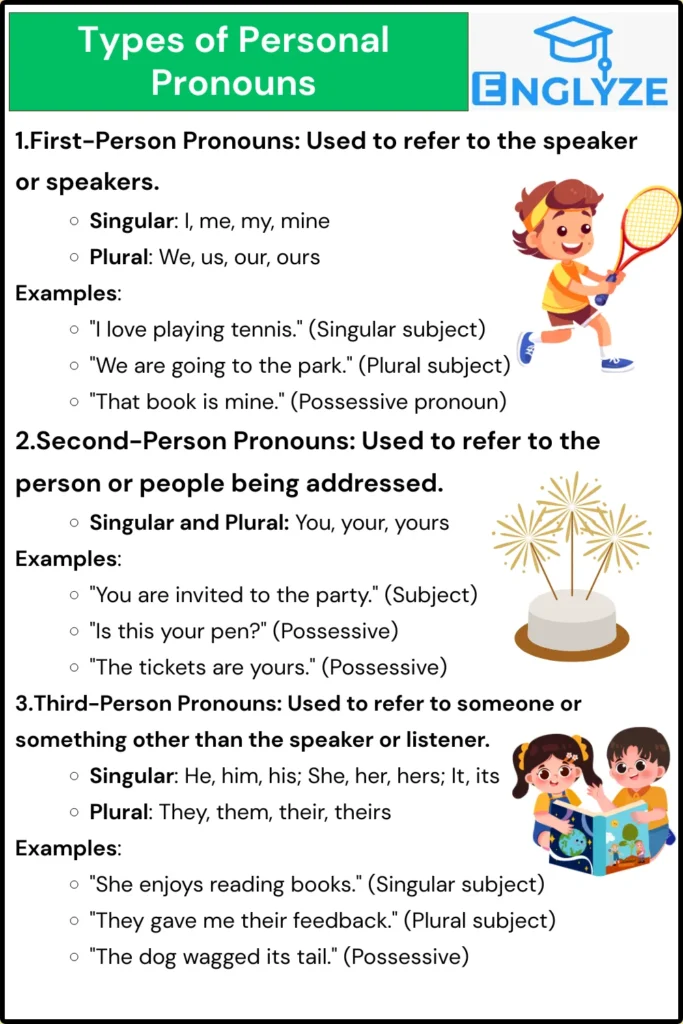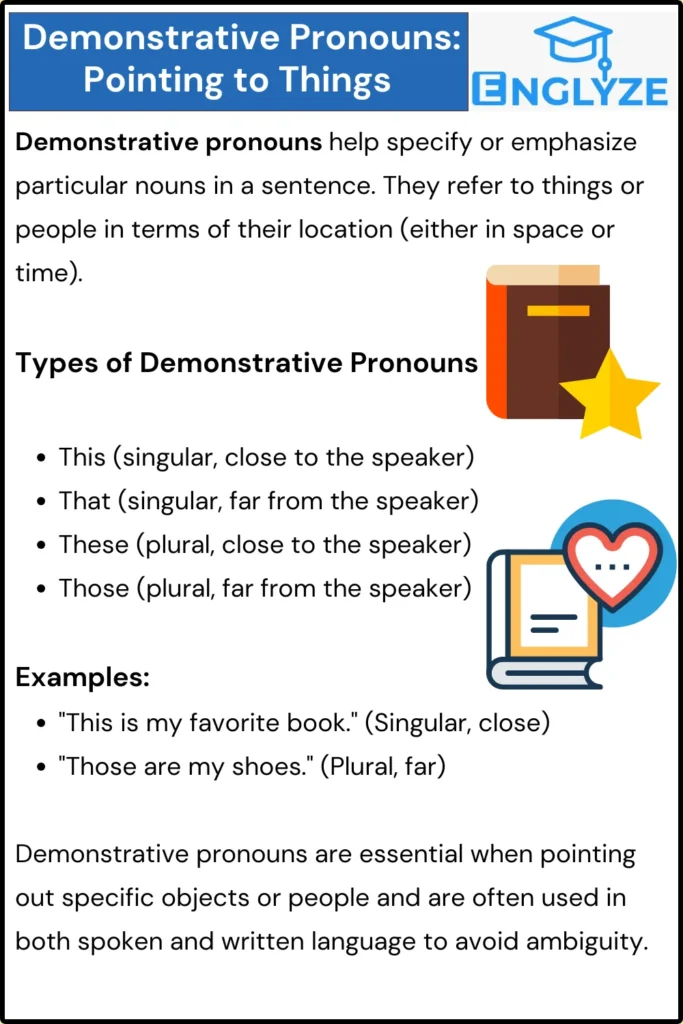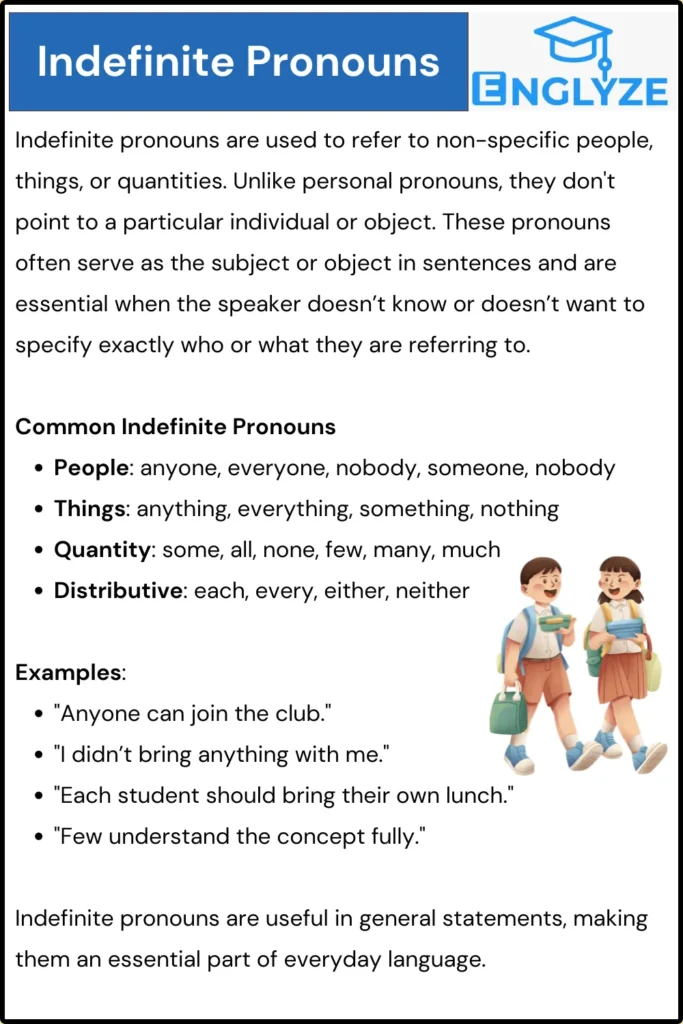Pronouns are an essential part of English grammar, serving as linguistic tools to simplify communication by replacing nouns. They help avoid redundancy and enhance sentence fluidity, making language more concise and efficient. At first glance, pronouns might seem like simple words, but they carry important grammatical and syntactical roles in English sentences. By delving deeper into the intricacies of pronouns, we can better appreciate their function in language.
What is a Pronoun?
A pronoun is a word that takes the place of a noun or noun phrase in a sentence. The primary purpose of a pronoun is to avoid the repetition of nouns, allowing for more concise and fluid sentences. Instead of repeating a noun, a pronoun can be used to reference that noun. Pronouns may refer to people, things, animals, ideas, or places, and they come in a wide variety of forms to accommodate different grammatical situations.
Key Points:
-
Pronouns replace nouns in sentences.
-
They improve sentence flow and reduce redundancy.
-
They can refer to people, objects, ideas, or places.
In English, pronouns can be classified into different categories, each serving a distinct function within a sentence. These categories help structure the language in a way that makes it easier to understand and apply in communication. As we move through this article, we will explore the different types of pronouns and their specific uses.
Common Pronouns in English:
-
Personal pronouns: e.g., I, you, he, she, it, we, they.
-
Demonstrative pronouns: e.g., this, that, these, those.
-
Interrogative pronouns: e.g., who, whom, what, which, whose.
-
Relative pronouns: e.g., who, whom, whose, which, that.
-
Indefinite pronouns: e.g., anyone, everything, nothing, some, all.
-
Reciprocal pronouns: e.g., each other, one another.
-
Possessive pronouns: e.g., mine, yours, his, hers, ours, theirs.
As we dive into the different types of pronouns, we will look at how each one functions in a sentence and provide detailed examples to help you understand their use in everyday language.
Pronouns vs. Nouns
Before we delve into the types of pronouns, it’s important to understand how they differ from nouns. Both pronouns and nouns are critical components of English sentences, but they serve different functions. A noun typically names a person, place, thing, or idea, whereas a pronoun replaces the noun in specific contexts to avoid repetition.
Key Differences Between Nouns and Pronouns:
-
Nouns name things, places, people, or ideas.
-
Example: The dog chased the ball.
-
-
Pronouns replace nouns in sentences.
-
Example: It chased the ball.
-
The relationship between pronouns and nouns is one of replacement and simplification. For example, if the sentence “Jessica is my friend. Jessica likes to read books” is rewritten using pronouns, it would become: “She is my friend. She likes to read books.”
By eliminating the repeated noun, the sentence becomes more concise and easier to read. This highlights one of the main advantages of pronouns in the language.
In the following sections, we will explore the types of pronouns in detail, starting with personal pronouns, which are among the most commonly used in English.

Personal Pronouns: Understanding Subject and Object Forms
Personal pronouns are one of the most commonly used categories in English. These pronouns are employed to replace the names of people, animals, or things. They vary depending on person, number, gender, and case (subject, object, or possessive).
Types of Personal Pronouns
-
First-Person Pronouns: Used to refer to the speaker or speakers.
-
Singular: I, me, my, mine
-
Plural: We, us, our, ours
Examples:
-
“I love playing tennis.” (Singular subject)
-
“We are going to the park.” (Plural subject)
-
“That book is mine.” (Possessive pronoun)
-
-
Second-Person Pronouns: Used to refer to the person or people being addressed.
-
Singular and Plural: You, your, yours
Examples:
-
“You are invited to the party.” (Subject)
-
“Is this your pen?” (Possessive)
-
“The tickets are yours.” (Possessive)
-
-
Third-Person Pronouns: Used to refer to someone or something other than the speaker or listener.
-
Singular: He, him, his; She, her, hers; It, its
-
Plural: They, them, their, theirs
Examples:
-
“She enjoys reading books.” (Singular subject)
-
“They gave me their feedback.” (Plural subject)
-
“The dog wagged its tail.” (Possessive)
-
Usage of Personal Pronouns:
-
Subject Pronouns replace the subject of the sentence.
-
Example: He ran to the store.
-
-
Object Pronouns replace the object of the sentence.
-
Example: I saw her at the mall.
-
-
Possessive Pronouns show ownership.
-
Example: That car is theirs.
-
Pronouns as Reflexive/Intensive Forms
Reflexive and intensive pronouns are special forms of personal pronouns that end in “-self” or “-selves”. Reflexive pronouns are used when the subject and object of the sentence are the same person or thing, while intensive pronouns emphasize a noun or pronoun.
-
Reflexive: myself, yourself, himself, herself, itself, ourselves, yourselves, themselves
-
Intensive: Same pronouns as reflexive, but used to emphasize.
Examples:
-
Reflexive: “She prepared herself for the exam.”
-
Intensive: “I myself completed the project.”
Demonstrative Pronouns: Pointing to Things
Demonstrative pronouns help specify or emphasize particular nouns in a sentence. They refer to things or people in terms of their location (either in space or time).
Types of Demonstrative Pronouns
-
This (singular, close to the speaker)
-
That (singular, far from the speaker)
-
These (plural, close to the speaker)
-
Those (plural, far from the speaker)
Examples:
-
“This is my favorite book.” (Singular, close)
-
“Those are my shoes.” (Plural, far)
Demonstrative pronouns are essential when pointing out specific objects or people and are often used in both spoken and written language to avoid ambiguity.

Interrogative Pronouns: Asking Questions
Interrogative pronouns are used to ask questions and gather information. They are crucial for forming queries and are typically followed by a verb in the sentence.
Types of Interrogative Pronouns
-
Who: Refers to people (subject or object).
-
Whom: Refers to people, used as the object of a verb or preposition.
-
What: Refers to things, ideas, or unspecified things.
-
Which: Refers to specific items among a known set.
-
Whose: Refers to ownership.
Examples:
-
“Who is coming to the party?”
-
“Whom did you call?”
-
“What is your favorite color?”
-
“Which one do you prefer?”
-
“Whose book is this?”
Interrogative pronouns allow for a wide range of questions, helping to gather specific details in conversations and written contexts.
Relative Pronouns: Connecting Ideas
Relative pronouns are used to introduce relative clauses, which provide additional information about a noun in the sentence. These pronouns connect clauses and help avoid repetition. Relative clauses often give more details about people, places, things, or ideas previously mentioned.
Types of Relative Pronouns
-
Who: Refers to people (subject of the relative clause).
-
Whom: Refers to people (object of the relative clause).
-
Whose: Indicates possession.
-
Which: Refers to things or animals.
-
That: Refers to both people and things.
Examples:
-
“The woman who called you is my sister.”
-
“The book that I borrowed was excellent.”
-
“The car whose owner is absent is parked outside.”
In relative clauses, the relative pronoun provides crucial details about the noun being discussed. These pronouns ensure clarity and provide a more cohesive structure to the sentence.
Indefinite Pronouns: Referring to Unspecified Entities
Indefinite pronouns are used to refer to non-specific people, things, or quantities. Unlike personal pronouns, they don’t point to a particular individual or object. These pronouns often serve as the subject or object in sentences and are essential when the speaker doesn’t know or doesn’t want to specify exactly who or what they are referring to.
Common Indefinite Pronouns
-
People: anyone, everyone, nobody, someone, nobody
-
Things: anything, everything, something, nothing
-
Quantity: some, all, none, few, many, much
-
Distributive: each, every, either, neither
Examples:
-
“Anyone can join the club.”
-
“I didn’t bring anything with me.”
-
“Each student should bring their own lunch.”
-
“Few understand the concept fully.”
Indefinite pronouns are useful in general statements, making them an essential part of everyday language.

Reciprocal Pronouns: Showing Mutual Action
Reciprocal pronouns are used when two or more subjects perform an action that is returned by the other(s). These pronouns convey the idea of mutual action or relationship.
Types of Reciprocal Pronouns
-
Each other: Used to indicate a reciprocal action or relationship between two people or things.
-
One another: Used for reciprocal actions involving more than two people or things.
Examples:
-
“The two friends helped each other with their homework.”
-
“The team members communicated with one another during the game.”
While many believe there is a distinction between “each other” (for two entities) and “one another” (for more than two), modern usage often treats them interchangeably.
Dummy Pronouns (Expletive Pronouns): Introducing Sentences
Dummy pronouns, also known as expletives, don’t have any real meaning on their own but are necessary for the sentence structure. They are used to introduce sentences, especially those concerning weather or existence, where there is no specific subject.
Common Dummy Pronouns:
-
It
-
There
Examples:
-
“It is raining outside.”
-
“There are many people at the event.”
Although they don’t refer to any specific noun, these dummy pronouns are grammatically necessary and help make the sentence sound complete.
Pronoun Antecedents: Establishing Clear Connections
Every pronoun has an antecedent, which is the noun it refers to. The antecedent establishes the pronoun’s meaning and ensures that the sentence is clear and understandable. In most cases, the antecedent comes before the pronoun in a sentence, but in certain structures, it can appear after the pronoun.
What is an Antecedent?
An antecedent is the noun or noun phrase that a pronoun refers back to. It is important to maintain clarity by ensuring that the antecedent is easily identifiable and unambiguous. Pronouns rely on antecedents for their meaning, and without a clear antecedent, the sentence can become confusing.
Examples:
-
“Jessica went to the store because she needed milk.”
(Here, “Jessica” is the antecedent for the pronoun “she.”) -
“The dog barked loudly, and it ran across the yard.”
(The antecedent for “it” is “the dog.”)
In some cases, the antecedent may not be explicitly mentioned in the sentence, but it remains understood by context. For instance, the pronouns “I” and “you” don’t need an antecedent, as their reference is clear from the speaker and the listener.
Pronoun Agreement: Ensuring Consistency
Pronoun-antecedent agreement is a fundamental rule in grammar. This rule requires that a pronoun must agree with its antecedent in number, person, and gender. This ensures that the pronoun correctly corresponds to the noun it replaces, making the sentence grammatically correct.
Key Agreement Guidelines:
-
Number Agreement: A singular antecedent requires a singular pronoun, and a plural antecedent requires a plural pronoun.
-
Example: “The boy loves his dog.” (Singular antecedent “boy” with singular pronoun “his”)
-
Example: “The boys love their dogs.” (Plural antecedent “boys” with plural pronoun “their”)
-
-
Person Agreement: Pronouns should match the person of their antecedent, whether it’s first, second, or third person.
-
Example: “I will finish my homework later.” (First-person antecedent “I” with first-person pronoun “my”)
-
-
Gender Agreement: A pronoun must agree with the gender of its antecedent.
-
Example: “The woman lost her keys.” (Feminine antecedent “woman” with feminine pronoun “her”)
-
Example: “The man lost his keys.” (Masculine antecedent “man” with masculine pronoun “his”)
-
-
Indeterminate Gender Agreement: In some cases, such as when the gender of a person is not specified, we use “they” as a singular, gender-neutral pronoun.
-
Example: “Each student should submit their assignment by Friday.”
-
Avoiding Ambiguity with Pronoun Use
Sometimes, pronouns can lead to ambiguity, particularly when the antecedent is not clear or when multiple potential antecedents exist. In such cases, it’s crucial to either restate the noun or rewrite the sentence for clarity. This is especially important in professional or academic writing, where precision is necessary.
Example:
-
Ambiguous Antecedent: “After the interview and the written test were completed, it was checked for incomplete answers.”
-
(It is unclear whether “it” refers to the interview or the test.)
-
-
Clear Revision: “After the interview and the written test were completed, the test was checked for incomplete answers.”
In this revision, the antecedent “test” is explicitly stated, ensuring that there is no confusion about what “it” refers to.
Special Pronouns: Nonstandard Forms and Uses
Some pronouns, such as one or you, do not require an antecedent or operate in a way that is somewhat unique to their function in sentences. The pronoun “one,” for instance, is used in formal language to refer to people in general, especially in philosophical or general statements.
Example:
-
“One should always strive to do their best.”
This construction, although a bit formal, is common in academic writing or advice-giving contexts.
Final Thoughts
Pronouns are indispensable tools in effective communication. They streamline sentences, eliminate unnecessary repetition, and help create a more fluid narrative. Whether you’re writing academic papers, crafting a professional email, or simply engaging in casual conversation, mastering pronouns will significantly improve your writing and speaking clarity.